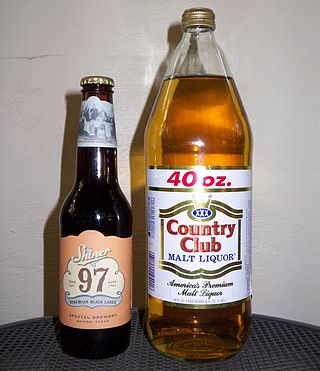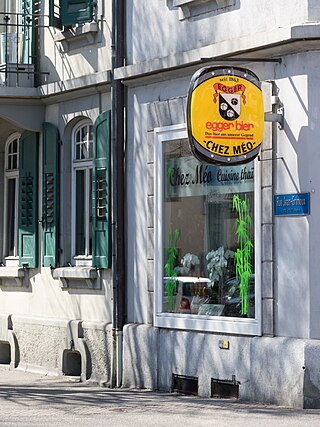Ice beer is a beer that has undergone some degree of freezing during production. These beers generally have a higher alcohol content, and lower price relative to it.

Low-alcohol beer is beer with little or no alcohol by volume that aims to reproduce the taste of beer while eliminating or reducing the inebriating effect, carbohydrates, and calories of regular alcoholic brews. Low-alcohol beers can come in different beer styles such as lagers, stouts, and ales. Low-alcohol beer is also known as light beer, non-alcoholic beer, small beer, small ale, or near-beer.

Empresas Polar is a Venezuelan corporation that started as a brewery, founded in 1941 by Lorenzo Alejandro Mendoza Fleury, Juan Simon Mendoza, Rafael Lujan and Karl Eggers in Antímano "La Planta de Antimano", Caracas. It is the largest and best known brewery in Venezuela, but has since long diversified to an array of industries, mostly related to food processing and packaging, also covering markets abroad.

Malt liquor is a type of mass market beer with high alcohol content, most closely associated with North America. Legally, it often includes any alcoholic beverage with 5% or more alcohol by volume made with malted barley. In common usage, it refers to beers of high alcohol content, generally above 6%, which are made with ingredients and processes resembling those for American-style lagers.

Corona is a brand of beer produced by Grupo Modelo in Mexico and exported to markets around the world. Constellation Brands is the exclusive licensee and sole importer of Corona in the fifty states of the United States, Washington, D.C., and Guam. Belgian company AB InBev owns the beer in all other worldwide markets and it solely brews the beer for all markets including the US. Corona is now brewed in China for the Australasia market. It is the top-selling brand of imported beer in the United States. It is often served with a wedge of lime or lemon in the neck of the bottle to add tartness and flavor. The recipe for the mash bill includes corn as well as the barley malt and hops traditionally used for making beer.

History of beer in Mexico dates from the Spanish conquest of the Aztec Empire. While Mesoamerican cultures knew of fermented alcoholic beverages, including a corn beer, long before the 16th century, European style beer brewed with barley was introduced with the Spanish invasion soon after Hernán Cortés's arrival. Production of this beer here was limited during the colonial period due to the lack of materials and severe restrictions and taxes placed on the product by Spanish authorities. After the Mexican War of Independence, these restrictions disappeared, and the industry was permitted to develop. Furthermore, the arrival of German immigrants during the ephemeral Second Mexican Empire of elected Maximilian I of Mexico, born an Austrian archduke, in the 19th century provided the impetus for the opening of many breweries in various parts of the country.

Beer in South Africa has a long history, with a corporate history dating back to the early 20th century.

Brazil is the world's third largest beer market with total volume at 139 million hectoliters, and per capita consumption 61 liters in 2016.
Beer in Africa, especially lager, is produced commercially in most African countries, and indigenous people also make varieties of beer. Beer is served in various locales, from neighbourhood shebeens to upscale bars. Many countries have standardized beer bottle sizes, which are cleaned and re-used, so when buying beer at a store, people often must pay a deposit on the bottle and the price of the beer. An alternative to glass-bottle beers is local beer sold in tetra-pak style paper cartons.

Malta is a lightly carbonated, non-alcoholic malt beverage brewed from barley, hops, and water. Corn and caramel color may also be added.

Beer in Japan mostly comes from the country's four major breweries, Asahi, Kirin, Sapporo and Suntory, which mainly produce pale lagers around 5% ABV. Beer is immensely popular, far ahead of sake consumption.
Beer is a popular alcoholic beverage in Turkey, mostly lager type beers.

Ajegroup, commonly known as AJE, is a Peruvian multinational company dedicated to the manufacture, distribution and sale of alcoholic and non-alcoholic beverages. The company was founded by the Añaños-Jerí Family in 1988 in Ayacucho, Peru. It is known for its flagship products Kola Real and Big Cola.

The primary beer brewed and consumed in Chile is pale lager, though the country also has a tradition of brewing corn beer, known as chicha. Chile's beer history has a strong German influence – some of the bigger beer producers are from the country's southern lake district, a region populated by a great number of German immigrants during the 19th century. Chile also produces English ale-style craft beers while also developing its own craft beer identity.

Beer in the Philippines is mainly produced by two large breweries, San Miguel Corporation, which produces San Miguel Pale Pilsen, and Asia Brewery, the country's second-largest brewery. In addition, there are a number of microbreweries across the nation.

Beer in Egypt has long held a significant role, and its presence in the country is thought to date back to the Predynastic period. In ancient Egypt wine was preferred by the upper class, whereas beer was a staple for working class Egyptians and a central part of their diet. Despite religious restrictions and conflicting views on alcohol after the Muslim conquest of Egypt, the consumption of beer did not cease, and it still remains the most popular alcoholic beverage in the country by far, accounting for 54 percent of all alcohol consumption.

Switzerland has a long tradition of brewing, with significant domestic beer production and a growing craft brewing sector.













